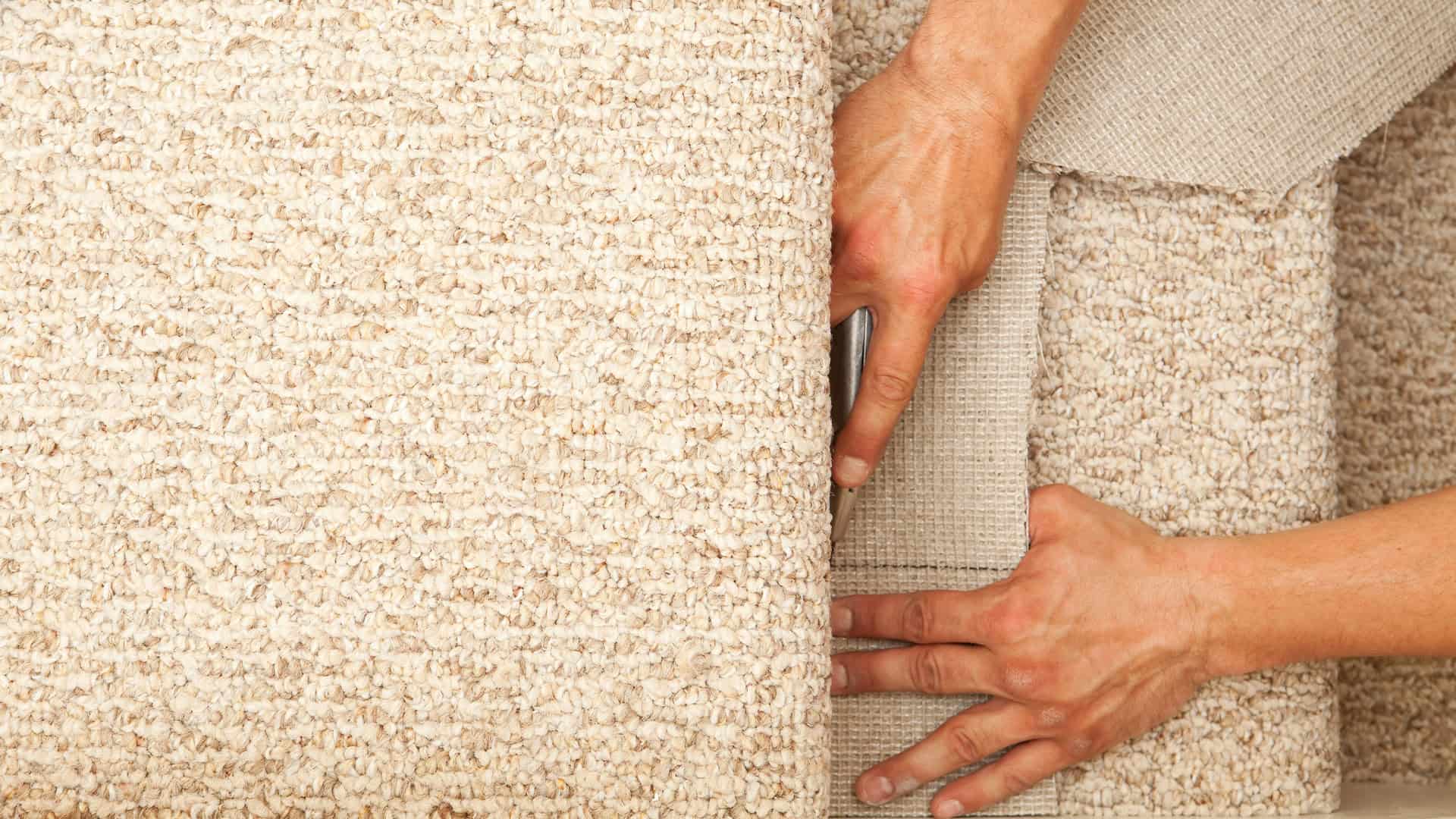So many factors can influence your overall spend when laying new carpet in your home. Based on the latest UK average costs, this guide will save you hours of research and give you a better idea of what you should be paying – before you get any quotes.
We break down the expenses involved in buying the carpet itself, adding underlay, fitting it, as well as the extra services you might need. We also cover how things like carpet quality, room shape, and installation method can affect the total price.
Whether you’re carpeting one room or the whole house, this guide is a great place to start.
In this guide
Carpet installation at a glance
Average carpet prices: £5 – £55 per m²
Average underlay cost: £2 – £11 per m²
Average carpet fitter day rate: £200 – £300 per day
What affects the cost of laying a carpet?
The type of carpet you choose
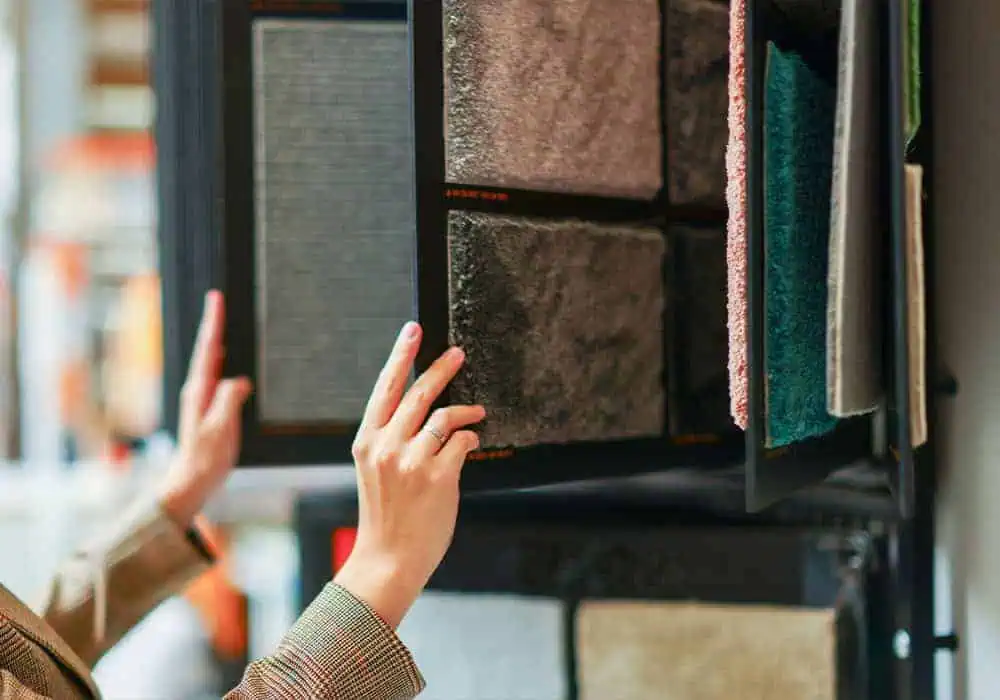
Carpets are usually priced per m2 and can vary wildly depending on:
Material quality: Carpets come in at different price points depending on the quality of the material. For example, due to its natural, luxurious appeal, a wool carpet will always be more expensive than a synthetic fibre like polypropylene or polyester.
Construction: Carpets are made using different methods which ultimately affects the cost. As an example, tufted carpets take less time to produce than woven, making them a more affordable option.
Durability: Hard-wearing carpets, like sisal, or stain-resistant options, like nylon, usually cost more because they last longer.
Sustainability: Environmentally friendly carpets are becoming more popular with eco-conscious homeowners, with biodegradable plant fibres—like jute, sisal and seagrass—coming in at a premium due to their limited availability and low carbon footprint.
Style: Unique patterns and intricate designs—like a floral broadloom—require a higher level of craftsmanship, bumping up the price.
Pile and density: Long-pile and high-density carpets—like velvet and Saxony—are known for their comfort and luxury, but they require more material and are, therefore, more expensive.
Brand: Reputable ‘designer’ carpet brands such as Brintons, Crucial Trading and Alternative Flooring command higher prices due to perceived value and reliability.
Average carpet costs per m2
The average UK carpet price is between £5 – £55m². That said, don’t be surprised to see top-of-the-range designer carpets priced at £100m² or more. Price points vary greatly depending on the brand, quality and specific characteristics.
To give you an idea of what you might pay, this table gives you the latest average carpet costs per m2 categorised by material:
| CARPET MATERIAL | AVERAGE COST PER M² |
|---|---|
| Budget | |
| Polypropylene | £5 – £10 |
| Polyester | £8 – £15 |
| Mid-Range | |
| Nylon | £15 – £25 |
| Wool Blend | £25 – £30 |
| Luxury | |
| Wool | £30 – £50 |
| Jute | £25 – £45 |
| Seagrass | £30 – £50 |
| Sisal | £35 – £55 |
Carpet fitter costs
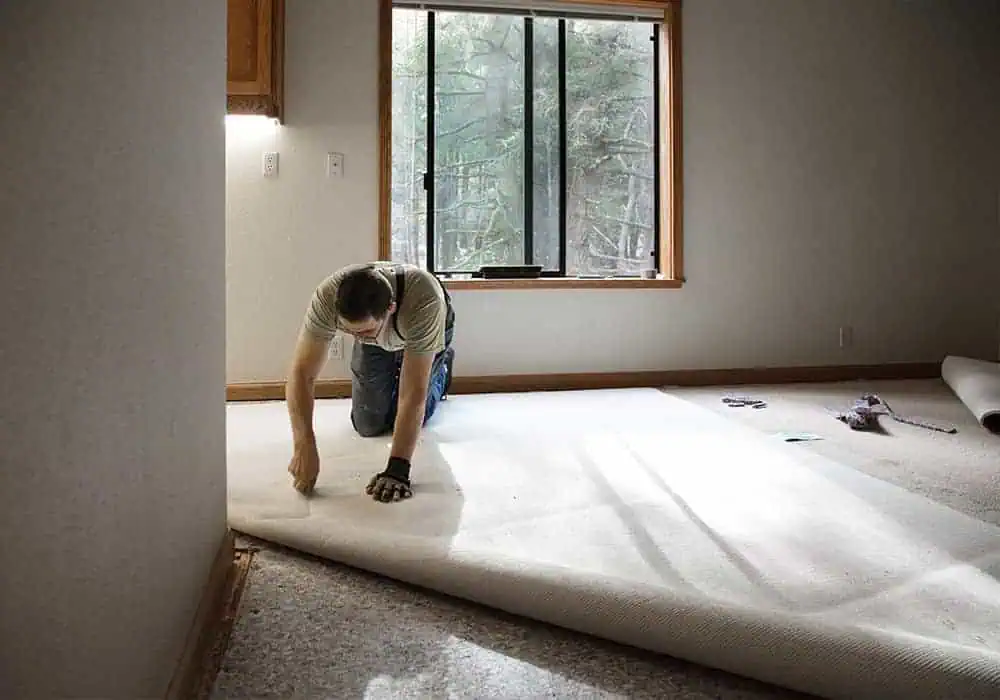
When it comes to laying your carpet, investing in a skilled installer guarantees a professional finish. The average day rate you can expect to pay for a carpet fitter in the UK is £200-300.
Quick tip: If you arrange your fitter through a carpet store, they’ll add on their own margins. It’s worth getting some independent quotes if you’re on a budget.
Room size and shape
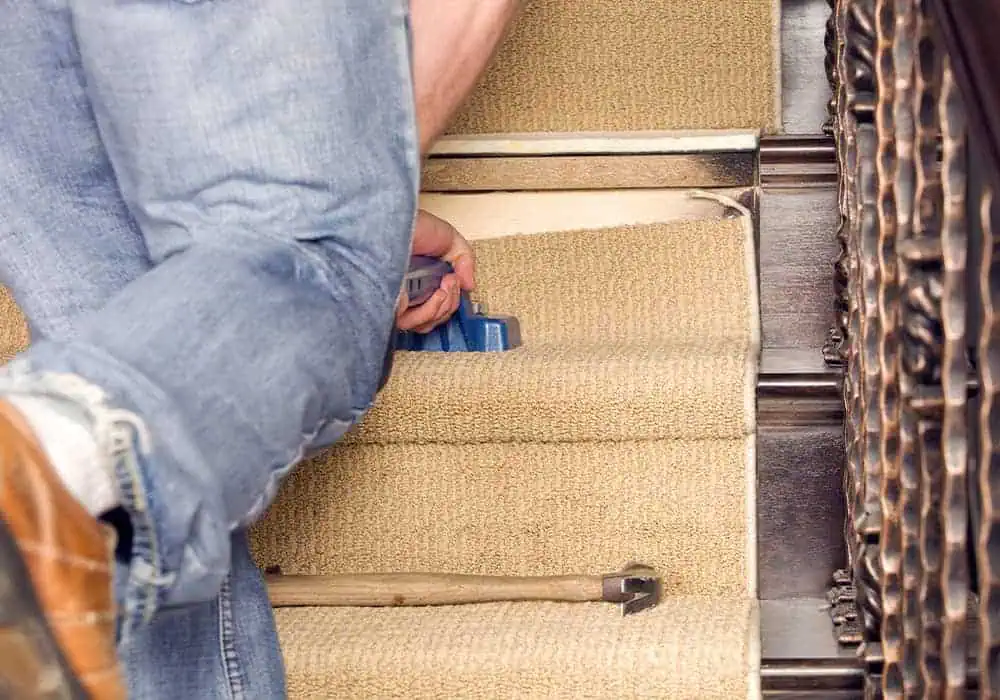
The size and shape of the room significantly impact the cost of laying a carpet. Larger rooms require more carpet, adding to the material and labour costs. If your room is oddly shaped with multiple corners, alcoves, or rounded edges, you’ll need to budget for extra cutting and fitting time.
When carpeting trickier spaces like stairs and landings, your choice of carpet, the size of the area, the number of stairs, and the shape of your staircase can all influence your total costs. Complex projects like these take longer due to labour-intensive tasks like installing stair runners, and precise cutting and shaping.
Good to know: Expect to pay a £50 – £100 premium for stairs and landings.
Installation method
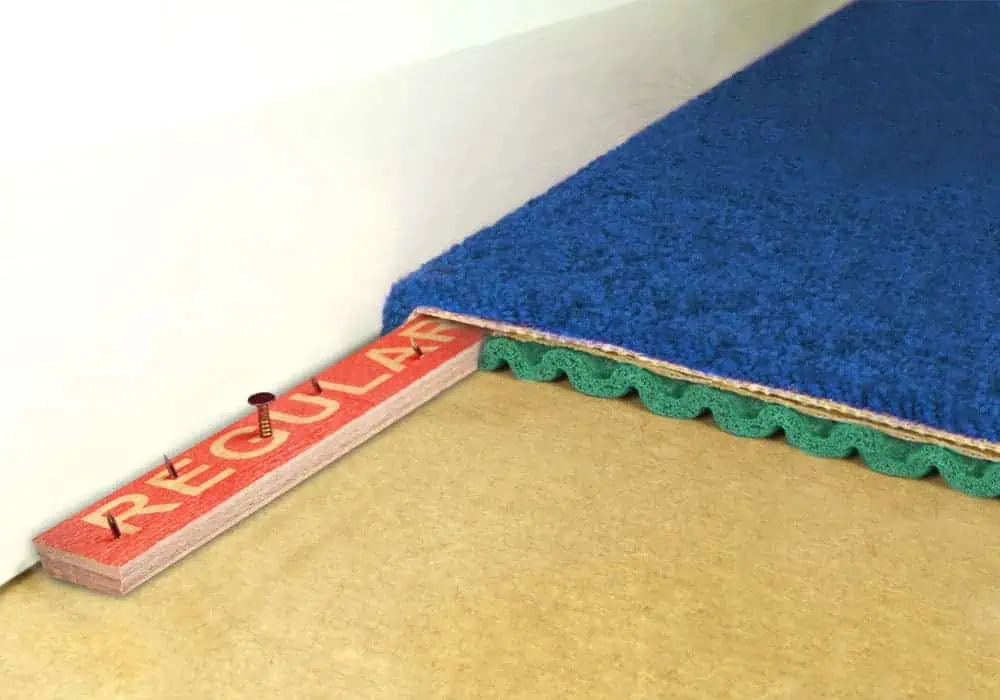
The method of installation can influence the overall cost of installing a new carpet. The standard stretch-fit method tends to be cheaper and works for most rooms.
However, double-sticking—a method necessary for carpets like sisal, seagrass, and jute—is more time-consuming and requires specialist skills, making it a more expensive option.
Underlay costs
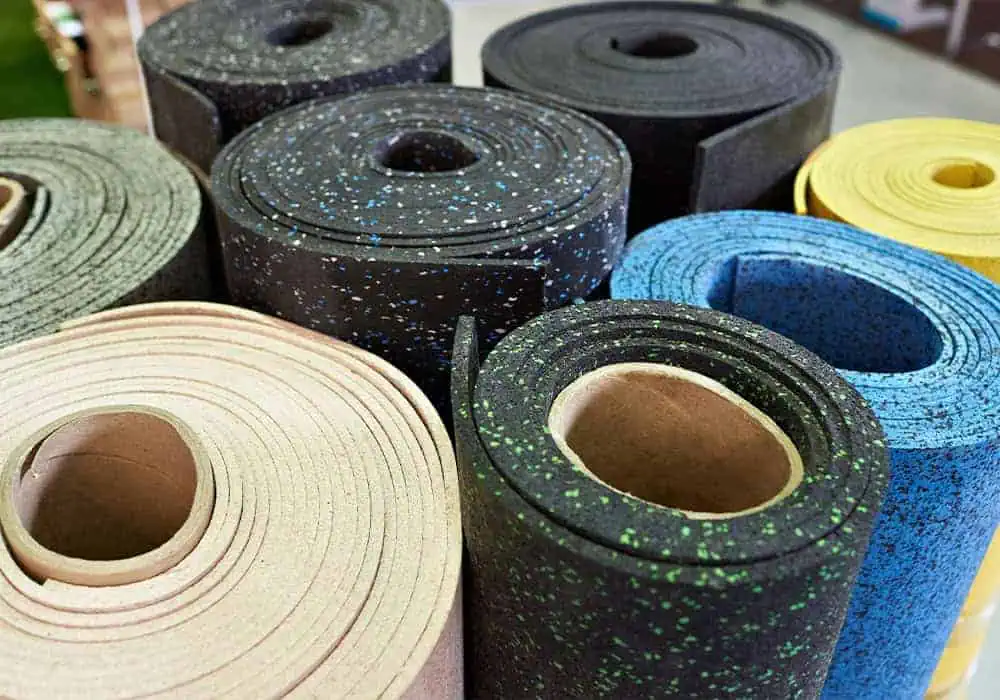
Carpet underlay is often overlooked in the carpet-buying process, but given that it helps your carpet look and feel better for longer, can make rooms warmer and less noisy, and can reduce your energy bills, it’s important to include it in your budget. No one wants unexpected expenses down the line.
As with carpets, underlay comes in a variety of materials, thicknesses and brands, each with their own uses and price points. Usually, the thicker, denser and more specialist it is, the more you can expect to pay.
Here are the most common underlay types on the market:
PU Foam (Polyurethane): The most popular and versatile underlay. It’s lightweight, easy to handle, budget-friendly, and works well in rooms with lower foot traffic.
Sponge rubber: Springy to walk on, durable, and mould-resistant – making it great for moisture-prone areas.
Crumb rubber: Dense, hard-wearing, great for high-traffic areas like stairs, and performs well under heavy loads (think furniture).
Some underlays have specialist features—like those compatible with sisal and double-sticking methods or low-tog options for underfloor heating—which tend to push them into the higher price bracket.
Average carpet underlay costs per m²
Here are the latest average prices for carpet underlay broken down by quality:
| CARPET UNDERLAY | AVERAGE COST PER M² |
|---|---|
| Budget | £2 – £4 |
| Mid-Range | £4 – £6 |
| Luxury | £6 – £11 |
Additional fitting costs to consider
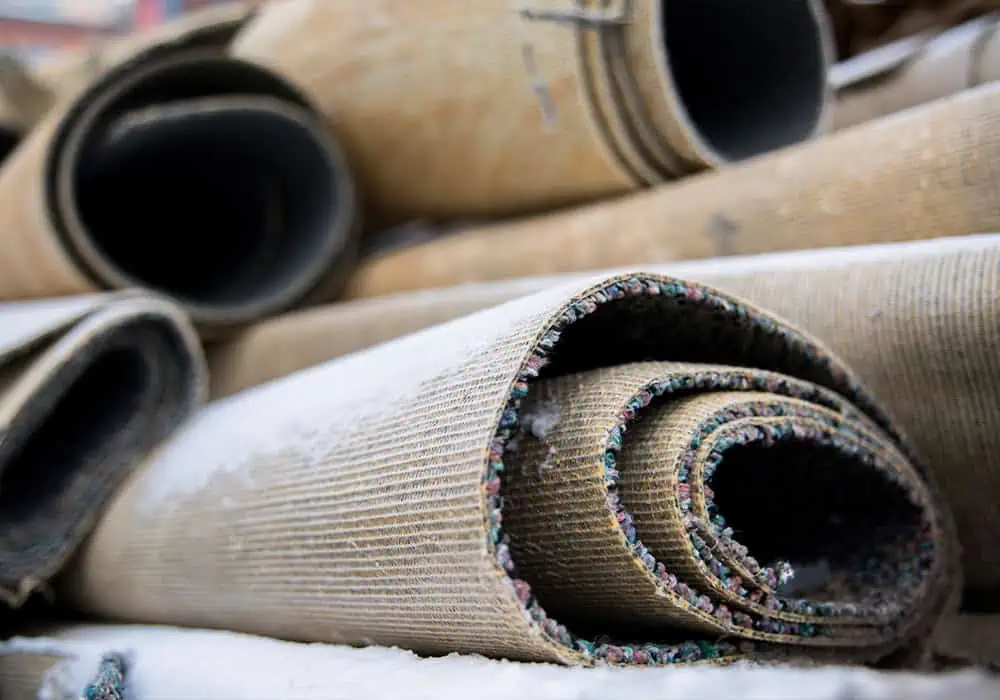
When budgeting, don’t forget to factor in the extra services and materials you might need:
Room clearance: If the room or area you’re carpeting needs to be cleared of furniture, debris or belongings, your fitter will charge extra for this service.
Subfloor repairs: When your old carpet comes up, it could reveal underlying issues, like an uneven surface, broken floorboards or moisture. Anything like this will need sorting out before your new carpet can go down. Whether your fitter is qualified to do this for you or you need to involve a flooring expert, be prepared for this to incur costs.
Removing old carpet and underlay: There will usually be an additional fee if you need the fitter to remove and dispose of your previous flooring (often called an ‘up and away’ service). It’s worth finding out whether this is included in the installation price.
Door easing: When laying a carpet, it’s common for your doors to need adjusting to allow them to open and close without catching. Your fitter may offer this service, but it might not be included in the price.
Additional materials: Things like gripper rods, door threshold strips and adhesive can increase your overall spend – especially if the carpet you’ve chosen requires specialist glues for double-sticking. It’s best to ask your chosen fitter upfront what is and isn’t included in their quote.
The below table includes the latest average costs you can expect to pay for carpet installation extras:
| CARPET FITTING SERVICES | AVERAGE PRICES |
|---|---|
| Room clearance | £10 – £15 per room |
| Subfloor repairs/levelling | £12 – £15 per m² |
| Previous flooring removal/disposal | £0.50 – £1 per m² |
| Door easing | £20 – £30 per door |
Average UK cost breakdown for carpet installation
Standard 3m x 4m room
Your overall spending will depend on various factors, but to give you a better idea, the table below gives average budget, mid-range and luxury cost examples of laying a carpet in a 3m x 4m room.
| COSTS | BUDGET | MID-RANGE | LUXURY |
|---|---|---|---|
| Carpet | Polypropylene £60 – £120 | Nylon £180 – £300 | Sisal £420 – £660 |
| Underlay | £36 – £72 | £36 – £96 | £60 – £144 |
| Accessories | £12 – £18 | £15 – £30 | £20 – £35 |
| Adhesives | £15 – £30 | £15 – £30 | £30 – £60 |
| Labour | £36 – £72 | £36 – £72 | £72 – £108 |
| TOTAL | £159 – £312 | £279 – £516 | £594 – £990 |
Regular 12-step flight of stairs
Using the same examples, here’s an idea of what the average price of laying a standard 12-step straight stair carpet would be.
| COSTS | BUDGET | MID-RANGE | LUXURY |
|---|---|---|---|
| Carpet | Polypropylene £25 – £50 | Nylon £75 – £125 | Sisal £175 – £275 |
| Underlay | £12 – £24 | £12 – £32 | £20 – £48 |
| Accessories | £5 – £8 | £10 – £13 | £15 – £18 |
| Adhesives | £6 – £13 | £6 – £13 | £13 to £25 |
| Labour | £15 – £30 | £15 – £30 | £30 – £45 |
| TOTAL | £63 – £124 | £113 – £207 | £243 – £401 |
Worth noting: Curved or winding staircases require more carpet, extra cutting and specialist skills, which increases the total price. Similarly, installing a stair runner will require
Tips for saving on carpet costs
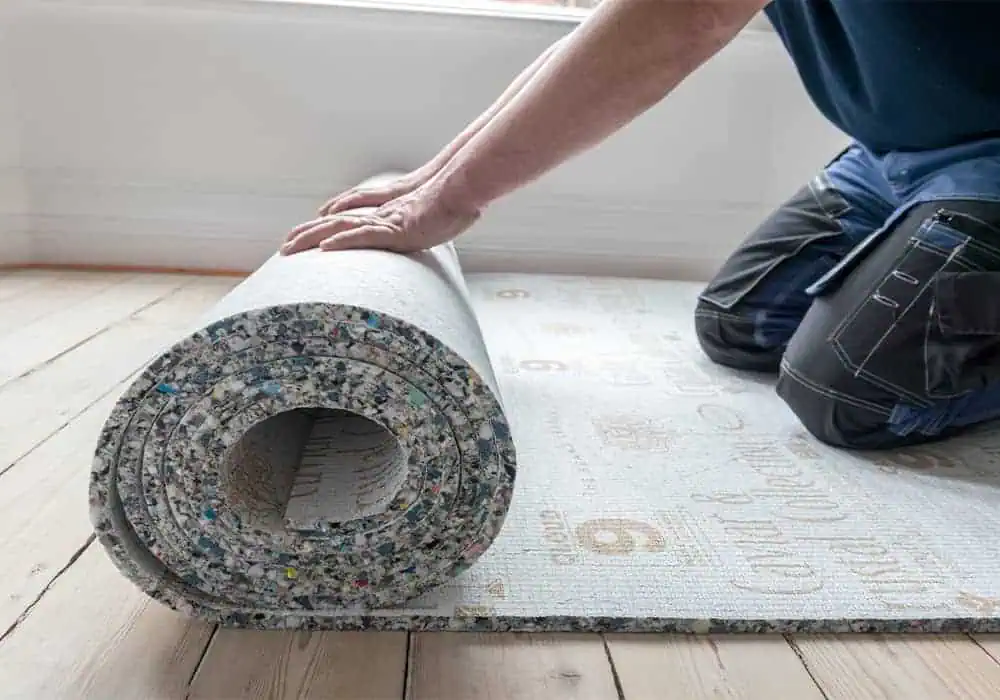
If you’re on a budget, there are ways to reduce the overall cost of laying new carpet:
- Measure accurately: If you’re out with your measurements you could end up over-ordering. See our guides for measuring a room and stairs correctly.
- Look around: Get quotes from a few different suppliers and fitters to find the best deal.
- Buy online: Online retailers often have lower overheads compared to stores, which can mean lower prices for you.
- Wait for sales: Take advantage of seasonal sales and promotions at carpet retailers.
- Choose a local fitter: This will save you paying additional travel costs.
- DIY: Consider laying the underlay yourself to reduce your overall costs.
- Prepare the room: Clear the room of furniture and old flooring before your fitter arrives to save on labour costs.
- Consider off–cuts and remnants: If you can find a carpet you like in the size you need, you can end up with a real bargain.
- Choose the right material for your lifestyle: For example, if you’ve got a young family and you’re considering wool, it’ll be harder to keep clean and you’ll likely have to replace it sooner. Choosing a material like nylon or polypropylene (the latter can often be bleach-cleaned) will help you deal with the inevitable stains and keep your carpet looking cleaner for longer.
Now you’re prepared
Now we’ve covered the factors that influence the cost of laying a carpet, as well as the potential costs involved, you can budget better, avoid any hidden expenses and make sure you’re getting the best value for money.

